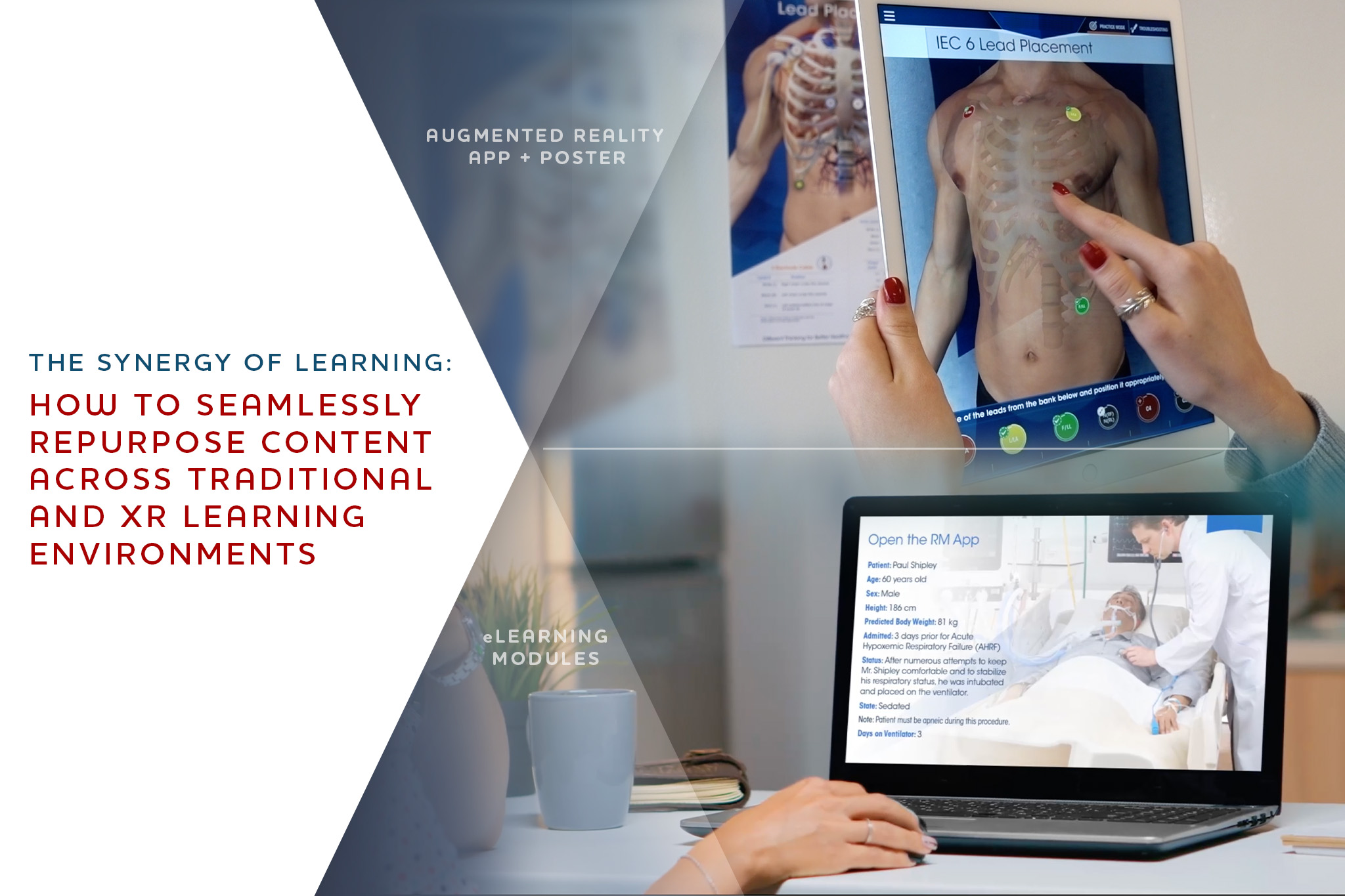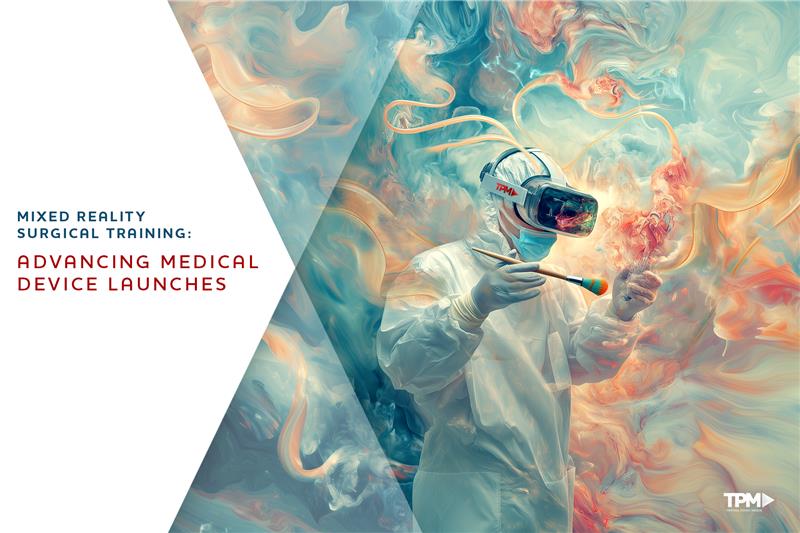In today’s fast-paced world, the demand for effective and efficient learning experiences is higher than ever. Healthcare educators and experience designers are constantly seeking innovative ways to engage learners and provide valuable knowledge. Content repurposing is one such method, involving adapting and reusing existing learning materials across platforms and mediums. This article explores the benefits of repurposing assets in learning environments within medical education, focusing on strategically aligning eLearning and extended reality (XR) to maximize ROI and facilitate immersive learning experiences. Reusing learning assets, especially medically illustrated 3D assets, is key, enabling educators to leverage existing content cost-effectively and engage learners in new ways. Also, repurposing learning content ensures accessible and adaptable knowledge for learners’ changing needs and preferences. This approach saves time and resources and helps maximize ROI, while creating interactive and personalized learning experiences, crucial in today’s educational landscape.
eLearning and XR in Healthcare Education
Extended reality, also known as XR, is an umbrella term that encompasses three main types of technology: virtual reality (VR), augmented reality (AR), and mixed reality (MR). These revolutionary technologies seamlessly merge the physical and digital worlds.
In recent years, the integration of technology in healthcare education has led to significant advancements in teaching and training methods. The use of eLearning platforms and extended reality (XR) technologies, such as virtual reality (VR) and augmented reality (AR), has transformed traditional approaches to healthcare education. These innovative tools have improved accessibility, engagement, and effectiveness in training healthcare professionals.
eLearning in Healthcare Education
eLearning platforms have gained popularity in healthcare education due to their numerous benefits. These platforms provide a flexible and convenient way for learners to access educational content at their own pace. Online courses, interactive modules, and webinars are readily available, making it easier for learners to acquire knowledge and skills.
One of the key advantages of eLearning in healthcare education is the ability to customize training programs according to individual needs. Learners can choose from a variety of courses and modules, allowing them to focus on areas that require improvement or explore new subjects of interest. This personalized approach enhances the learning experience and ensures that learners gain the necessary knowledge and skills to excel in their respective fields.
Furthermore, eLearning platforms often incorporate multimedia elements such as videos, simulations, and interactive quizzes to enhance the learning process. These visual and interactive components not only make the content more engaging but also facilitate better retention and understanding of complex medical concepts. Learners can also collaborate with peers and instructors through discussion forums and virtual classrooms, fostering a sense of community and facilitating knowledge sharing.
Extended Reality (XR) in Healthcare Education
Healthcare education has embraced the use of extended reality (XR) technology to enhance the learning experience for healthcare professionals (HCPs) and patients. XR, which includes virtual reality (VR), augmented reality (AR), and mixed reality (MR), offers immersive and interactive experiences that simulate real-life scenarios. For HCP education, XR allows students and professionals to practice procedures and scenarios in a safe and controlled environment, improving their skills and confidence. It also enables remote training and collaboration, breaking down geographical barriers. Additionally, XR is utilized in patient education to enhance understanding of medical conditions and treatment options through visualizations and interactive simulations, empowering patients to make informed decisions about their health. Overall, the integration of XR in healthcare education has revolutionized the way knowledge is shared and absorbed, resulting in more effective and engaging learning experiences for both HCPs and patients.
3D Medical Illustration in XR
One of the key aspects of healthcare education is the use of 3D medical illustrations. This technology allows learners to explore anatomical structures and medical procedures in a three-dimensional space. By providing a realistic and immersive experience, 3D medical illustration enables learners to gain a deeper understanding of complex medical concepts.
Be it eLearning simulation or VR and AR, learners can interact with virtual models of organs, tissues, and body systems. They can rotate, zoom in, and manipulate these models to visualize intricate details and relationships. This hands-on approach enhances spatial awareness and helps learners develop a comprehensive understanding of anatomical structures or visualize healthcare concepts comprehensively.
Recent study: Impact of learning asset reuse on ROI
A recent article published on MDPI mentions “The urgent need for digital transformation within healthcare settings was accelerated since the outbreak of the coronavirus in 2019”
The Study concludes with “The metaverse in education in healthcare has great potential to be an interactive and immersive application that can be modified for each person [21]. It can support educators to implement interactions with patients as well as trainees that can be more caring in many ways.”
Another study published on JMIR Publications quotes “…costs virtually nothing for the nurse and perhaps a nominal fee for the developer. Why would an educator want to recreate or even offer such a training opportunity when it already exists”
These studies emphasize the growing adoption of XR into Healthcare education and further assert the promising ROI on reusing virtual assets for Learning and Development. More studies are being conducted as innovation continues to be at the forefront of emerging technologies.
Maximizing ROI through Content Reuse and Repurposing
One way to maximize ROI through content repurposing is by adapting materials for different platforms and mediums. For example, repurposing an instructor-led training program into self-paced eLearning modules allows educators to reach learners who may not have access to traditional classroom settings. Similarly, repurposing eLearning content for XR learning environments ensures a more immersive and interactive learning experience.
Another method to maximize ROI is through the reuse of learning assets. By repurposing existing materials like videos, images, or interactive simulations, educators can save time and resources. Repurposed assets can also be continuously updated and improved to keep the learning experience relevant.
Repurposing learning assets and content enhances the learning experience and maximizes ROI. Investing in a 3D asset for a less complex learning build with phased goals can lead to greater ROI as training technology evolves. Repurposing existing assets and content helps organizations effectively utilize resources and disseminate valuable knowledge to a wider audience. This insight can inform strategic stances for training evolution within organizations.
The Intricate Process of Building Reusable Assets and Content
Building reusable assets and content is a complex and intricate process that requires careful planning and execution. In today’s digital landscape, creating reusable assets and content has become essential for businesses looking to maximize efficiency and maintain a consistent brand identity.
The Smart Design: Experience Designer’s Role
The role of an experience designer is crucial in creating platform-agnostic and scalable assets. They focus on understanding learners’ needs, goals, and preferences to create engaging and interactive learning experiences. To achieve this, experience designers consider content structure, user interface design, interactivity and engagement, accessibility and localization, and scalability. By carefully structuring content, designing intuitive interfaces, incorporating interactive elements, and ensuring accessibility and scalability, experience designers create adaptable learning materials for different contexts and audiences. This saves time and resources while providing high-quality learning materials.
For example, To bring the design alive, a team of experts uses tools like Unity and Maya to create accurate 3D illustrations of human anatomy. These tools play a crucial role in creating realistic and detailed representations.
3D Medical Illustration: How it is a smart move to reuse?
Creating a 3D medical illustration involves several phases, each requiring specific expertise and resources. The process can be divided into the following phases: concept development, data acquisition, modeling, texturing, lighting, rendering, and post-production.
The process of creating 3D views for Medical illustration is time-consuming and requires a team of skilled professionals, including medical experts, artists, and technical specialists. The cost involved in creating a 3D medical illustration can vary depending on factors like the complexity of the project, the level of detail required, and the expertise of the team involved.
The data acquisition phase, in particular, can be time-consuming and costly, as it requires access to high-quality medical imaging data and specialized software. The modeling and texturing phases also require a significant investment of time and expertise to create accurate and realistic anatomical structures.
Additionally, the rendering phase can be computationally intensive, requiring powerful hardware and software resources to achieve high-quality results in a reasonable amount of time. The cost of these resources can contribute to the overall cost of creating a 3D medical illustration.
Overall, the process of creating a 3D medical animation, such as 3D anatomy and surgical simulation, is a complex and involved one, requiring expertise, time, and resources. The impact on cost and time can be significant, especially for projects that require a high level of detail and accuracy. However, the result can be immensely valuable for medical education making the investment worthwhile.
Creating content and assets with a strategic vision:
The combination of strategic vision and smart design helps build modules and assets that can be reused or personalized across learning mediums and in turn, can maximize ROI.
For instance, a 3D model that was originally used for visualization purposes in a classroom setting can be built for a self-paced eLearning to provide learners with a visual and interactive representation of complex concepts, making them easier to understand and remember.
To take it to the next level, the assets that were built for this eLearning could be reused to leverage the power of XR technologies. Educators can transform traditional self-paced eLearning materials into dynamic, interactive, and immersive experiences that enhance knowledge acquisition, retention, and overall learning outcomes.
Best practices for Reusing and Repurposing Content and Assets in Healthcare Education
Adapt content for different learning styles and modalities:
Recognize diverse learning styles and preferences. Repurpose content and assets for visual, auditory, and kinesthetic modalities. For example, convert text-based resources into interactive simulations or create audio versions of lectures.
Leverage technology and multimedia:
Use technology and multimedia tools to enhance learning. Incorporate interactive elements, animations, videos, and VR simulations. This improves knowledge retention and provides an immersive learning experience.
Assess and measure effectiveness:
Regularly assess and measure reused content. Collect feedback from learners and educators. Analyze learner performance data to determine if content meets learning outcomes. Use feedback to refine content.
Respect copyright and Licensing:
Comply with copyright laws and licensing agreements. Obtain necessary permissions for third-party content. Consider using open educational resources and Creative Commons licensed materials with proper attribution.
By following these best practices, healthcare educators can optimize content creation, enhance learning experiences, and improve healthcare education quality. Reusing and repurposing content saves time and resources, allowing educators to focus on refining instructional strategies and delivering personalized learning experiences to students.
Conclusion: Embracing the synergy of traditional and XR learning
Repurposing learning content between eLearning and XR learning environments in healthcare education benefits educators, learners, and healthcare professionals. It optimizes resources, reaches a wider audience, and provides engaging and interactive learning experiences. Integrating traditional and XR learning allows for a holistic and personalized approach to healthcare education, catering to diverse preferences and needs. To embrace the synergy of traditional and XR learning in healthcare education, educators and experience designers in the healthcare field should leverage content repurposing. Understanding the benefits, best practices, and tools for repurposing learning content helps create impactful educational experiences that maximize ROI in healthcare settings. Contact Tipping Point Media for a demo and start harnessing the power of content repurposing in your healthcare learning environments


![How Augmented Reality Packaging Is Transforming Pharma Sales [2025 Guide]](https://tipmedia.com/wp-content/uploads/2024/10/blog-ARpackaging-2.jpg)
